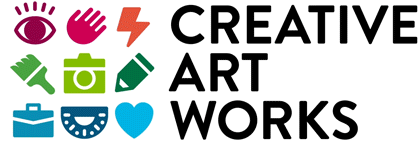What Does Your Self-Portrait Say About You?
What Does Your Self-Portrait Say About You?
“This is me in the garden. This is my pet goldfish. And this is a bird. ”
Creative Art Works is offering an after-school art-making program for second-grade students at PS 192 in Hamilton Heights. We sat in on a class on making self-portraits that engaged a very energetic group of young artists on many levels. Not only did students in this literacy-based program have an opportunity to make art, they also developed public speaking, problem-solving, fine motor and observation skills.
Ants in the Pants
“Be a tree!” Stretching and movement games help second-graders burn off excess energy before sitting down to make art.
When you are in the second grade, ants in the pants are not a bug, they’re a feature. That’s why Teaching Artist Laura Mychal starts each class with stretching and movement games that burn off excess energy so her students can focus on their art. This is followed by a brief reminder of the classroom agreements, which include, “Be prepared to be called on,” “Raise your hand to speak,” and “Respect your materials.”
What do you see in Frida’s self-portrait?
“What do you see in Frida’s self portrait?” Frida Kahlo’s self portraits often featured pets and plants from her garden.
Students were introduced to the art of Frida Khalo in a previous class through the picture book, Frida by Jonah Winter and Ana Juan. On this day, Laura shows her class two of Frida’s self-portraits, and asks, “What do you see in the background?” Khalo packed her self-portraits with images of things that were important to her, including her many pets and different plants from her garden.
Laura encouraged the budding artists to add details from their own lives to their portraits. Many drew images of the sun, their local park, or their home. One child dramatized a fire in his neighborhood.
The importance or experimentation
A chance to play with materials allows artists at any age to gain new skills and hone existing ones. Working with colored pencils and oil pastels, the children experimented with blending colors and making different kinds of lines and patterns.
Prompted by their teacher, they also explored what kind of shapes make up a face. Drawing analogies came in handy. When a child doesn’t have a name for the shape of an eye, Laura asks, “What does it remind you of? Maybe your eyes are shaped like an almond?”
A chance to experiment with materials is vital to developing art skills.
“By making self-portraits, they’re learning how to recognize shapes, how to hold utensils and how to use different kinds of drawing materials. They’re learning about mixing colors. And there’s learning how to look closely and see different colors in the things around them, which sharpens their powers of observation.”
One picture, lots of questions
“What does your self portrait say about who you are?”
While several students were eager to share their work during the reflection period, all of the students wanted to know the story behind their classmates’ drawings and how the different elements connected to the artist. They crowded around the art, straining to raise their hands to the ceiling. It was an authentic moment for children to talk about themselves and their art, and to find out about each other.
This after-school program is just one of over a dozen in-school, out-of-school time and public art youth employment programs Creative Art Works is offering this fall in Manhattan, Brooklyn, Queens and the Bronx.
A Gallery of Self-Portraits
This Creative Art Works program is supported, in part, by public funds from the New York City Department of Cultural Affairs and the Cultural After-School Adventures (CASA) Initiative in partnership with the City Council and Council Member Mark D. Levine.













